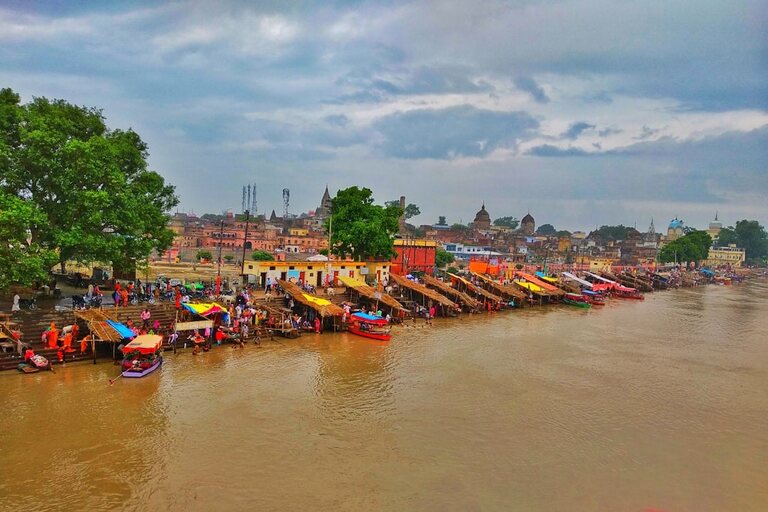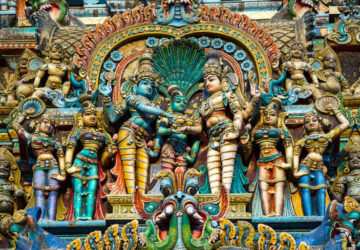
Ayodhya is a city situated in the northern Indian state of Uttar Pradesh. It is widely regarded as the birthplace of Lord Rama, one of the most revered deities in Hindu mythology. The city has a rich and ancient history spanning several millennia and is renowned for its numerous temples, monuments, and religious sites. Ayodhya Ram Mandir is believed to have been built on the spot where Lord Rama was born and is considered a holy place for Hindus.
We will now explore the history and significance of the Ayodhya Ram Mandir, along with other places to visit in the city.
Ayodhya Uttar Pradesh: Location
Ayodhya is a city located in the northern Indian state of Uttar Pradesh. It is situated on the banks of the Sarayu River, approximately 130 kilometres east of Lucknow, the capital of Uttar Pradesh. The city holds immense religious and cultural significance in Hinduism, primarily because it is believed to be the birthplace of Lord Rama, a revered deity in the Hindu scriptures. It attracts pilgrims and tourists who visit its various temples and historical sites, with the Ayodhya Ram Mandir being a central point of religious interest.
Best Time to Visit Ayodhya
The best time to visit Ayodhya largely depends on personal preferences and weather considerations. For those who prefer pleasant weather and comfortable temperatures, the winter months from October to February are ideal. During this period, the weather in Ayodhya is cool and pleasant, with temperatures ranging from around 10°C to 25°C. This makes it an ideal time to explore the city’s historical and religious sites.
On the other hand, the summer months from March to June can be quite hot, with temperatures soaring above 40°C. While outdoor activities might not be the most comfortable time, those who can tolerate the heat may find fewer crowds at popular tourist destinations.
The monsoon season spans from July to September, bringing moderate to heavy rainfall to Ayodhya. While the rain contributes to a lush green landscape, it may not be the preferred time for sightseeing due to the wet conditions. Travellers should consider their tolerance for heat and rain when planning a visit to Ayodhya and choose the time that aligns with their preferences and comfort levels.
Ayodhya History: Ayodhya Ram Mandir History
Ayodhya, with its roots deeply embedded in India’s history and religious fabric, has garnered attention primarily due to the Ayodhya Ram Mandir and the historical disputes surrounding it. The Ayodhya Ram Mandir’s history is intertwined with the epic Ramayana, making it a significant pilgrimage site for Hindus.
Ayodhya Ram Mandir’s history dates back to the 11th century when it was originally constructed as a dedication to Lord Rama. This temple became a revered place of worship for centuries, symbolising devotion and faith. However, things took a dramatic turn during the Mughal era in the 16th century. Despite this, the temple still holds great significance as a testament to its followers’ enduring faith and devotion throughout Ayodhya Ram Mandir’s history.
Emperor Babur had ordered the construction of the Babri Masjid on the site where the Ram Mandir already existed. This resulted in a long-standing religious and cultural dispute that continued for centuries. The disagreement over the ownership of the land became the centre of contention between the two communities, leading to legal battles and social tensions.
Things took a significant leap in 2019 when the Supreme Court of India delivered a historic verdict on the long-standing Ayodhya land dispute. The court granted permission to construct the Ayodhya temple at the disputed site, acknowledging the historical and religious significance of the place.
This legal resolution ended a long struggle, closing a contentious chapter in Indian history. The verdict allowed for the reconstruction of the Ram Temple while allocating an alternate site for constructing a mosque, aiming to foster communal harmony and religious tolerance.
The Ayodhya Ram Mandir’s history, therefore, encapsulates the temple’s architectural and religious evolution and the socio-political landscape that has surrounded it for centuries. The recent legal resolution holds the promise of a new chapter, emphasising coexistence and respect for diverse religious beliefs in this sacred city.
Ram Mandir Architecture
Apart from the Ayodhya Ram Mandir’s history, there are some other interesting things that make the Ayodhya Ram Janmabhoomi temple an important site. The architectural grandeur of the Ayodhya Ram Mandir Uttar Pradesh site is a testament to the skilled craftsmanship of ancient India. The temple’s intricate carvings and majestic structures reflect various architectural styles, encompassing Nagara and Dravidian influences.
The main sanctum, or garbhagriha, houses the idol of Lord Rama in the form of a five-year-old boy. The temple complex houses a 51-inch idol made of black stone, depicting Lord Ram in a standing posture. As per reports, the idol of Lord Ram is placed on the ground floor, while the idols of Sita, Hanuman, and Ram’s brothers will be placed on the first floor. The complex flaunts a grand Shikhar (spire) and intricate sculptures that depict various episodes from the Ramayana. Additionally, there are expansive courtyards to accommodate the multitude of pilgrims visiting the temple.
Ayodhya Ram Mandir Uttar Pradesh Detailed Architectural Features
The Ram Temple is a testament to the exquisite fusion of artistic vision and traditional architectural expertise, showcasing a design combining grandeur with intricate detailing. Led by the visionary Chandrakant Sompura and drawing inspiration from various temples, the Ram Mandir architecture is a symbol of creative brilliance. Let’s delve into some fascinating architectural highlights of this monumental structure.
- Foundation: When it comes to the Ram Mandir architecture, the temple’s foundation is an important aspect. At the core of the temple’s structural integrity lies a robust foundation. Crafted meticulously, a formidable 14-meter-thick layer of roller-compacted concrete forms a solid artificial rock that provides a stable base. Complementing this, a substantial 21-foot-high plinth of granite adds further strength and guards against ground moisture.
- Main Temple: The main temple, a towering testament to Hindu temple grandeur, follows the Nagara style. The temple showcases Lord Rama’s journey across three floors by comprising five Mandaps or halls – Nritya, Sabha, Rang, Kirtan, and Prarthna. Boasting 44 doors, some coated with 100 kg of gold, the temple exudes opulence.
The Singh Dwar, the main entrance, welcomes visitors with statues depicting tales from the Ramayana. Pillars and walls adorned with deities and intricate carvings serve as historical canvases. The parikrama path, with 100 events from Valmiki’s Ramayana engraved, turns the temple into a must-visit gem on Ayodhya tour packages. The Ram Mandir architecture is spectacular and impressive, making it a top place to visit in Ayodhya.
- Temple Complex: The Ram Mandir is enclosed by a rectangular compound wall called Parkota. This wall measures 732 meters in length and 14 feet in width, ensuring security. The complex extends beyond the main temple, housing other temples dedicated to deities like Bhagwati, Surya Dev, Ganesh Bhagwan, Lord Shiva, and Devi Bhagwati. Notable additions include the temple of Maa Annapurna in the northern part and a temple dedicated to Lord Hanuman in the southern part.
Plans envision temples for Maharishi Vashishtha, Maharishi Vishwamitra, Maharishi Valmiki, Nishad Raj, Maharishi Agastya, Mata Shabri, and Devi Ahilya. The complex also hosts amenities such as medical facilities, locker rooms, bathing areas, and a museum exhibiting artefacts related to Ramayana and Lord Rama.
Other Ram Mandir Architecture Facts
The Ayodhya Ram Temple, beyond its religious and cultural significance, incorporates unique architectural features. A time capsule buried approximately 2,000 feet below the ground safeguards the temple’s legacy. Crafted to be earthquake-resistant, the temple’s idols are carved from Shaligram Rocks, believed to be 60 million years old and sourced from the Gandaki River in Nepal. Adding to the mystique, the bell, composed of Ashtadhatu (Gold, Silver, Zinc, Copper, Tin, Lead, Mercury, and Iron), weighs an impressive 2100 kg, with its sound resonating up to 15 kilometres.
Ayodhya History: Significance of Ram Mandir
The Ayodhya Ram Temple is a crucial part of Ayodhya’s history, deeply rooted in its cultural and religious setting. Dating back to the 11th century, it reflects the enduring spirit of Ayodhya through the ages. The temple, a central figure in Ayodhya’s history, attracts devotees from far and wide, serving as a cultural and religious significance hub.
Beyond its religious importance, the Ayodhya temple was key in resolving a historical dispute. In 2019, a landmark decision brought closure to a long-standing issue, marking a defining moment in Ayodhya’s history. This resolution allowed for the temple’s construction, symbolising triumph and contributing to Ayodhya’s evolving history.
The Ayodhya temple is more than just an architectural wonder. It is a symbol of communal harmony, representing the convergence of diverse cultures in this sacred space and showcasing an inclusive spirit. The temple stands as a symbol of coexistence, attracting visitors to admire its beauty and significance in Ayodhya’s history. With Ayodhya tourism, you can explore this amazing land’s rich and fascinating history. Come witness the deep beauty of Ayodhya and its Ram Temple, with its roots deeply embedded in history.
Social Impact of the Ram Mandir
The Ram Mandir has been a topic of great importance and significance in India. It is believed that the construction of the temple will have a profound impact on the social fabric of India. Let’s look at it in detail:
- Communal Harmony: The construction of the Ayodhya Ram Mandir has played a pivotal role in Ayodhya’s history. The temple has helped foster communal harmony. The resolution of the longstanding dispute has become a symbol of unity, bringing together people from diverse backgrounds to celebrate a shared cultural heritage.
- Tourism and Economy: The Ayodhya Ram Mandir has become a major pilgrimage site, attracting devotees nationwide. This influx of pilgrims has contributed significantly to the local economy, boosting tourism-related businesses and generating employment opportunities.
Places to Visit in Ayodhya
Here are some recommendations for places to visit in Ayodhya.
- Hanuman Garhi: One of the top attractions in Ayodhya, the Hauman Garhi is a significant temple dedicated to Lord Hanuman. It is perched atop a hill and provides panoramic views of Ayodhya. Devotees believe that visiting Hanuman Garhi brings blessings and fulfils wishes.
- Kanak Bhawan: This temple is dedicated to Lord Rama and Sita and is known for its intricately carved interiors. The name “Kanak Bhawan” translates to “Golden House” and signifies the opulence associated with the divine couple.
- Treta Ke Thakur: This temple marks the spot where Lord Rama is believed to have performed the Ashwamedha Yagna. It is an essential pilgrimage site for those seeking a deeper connection to the Ramayana.
- Ram Ki Paidi: A series of ghats along the banks of the Sarayu River, Ram Ki Paidi is a sacred bathing spot. Devotees believe that taking a dip in the holy river here cleanses them of sins.
Things To Keep in Mind When Visiting Ayodhya
When visiting Ayodhya, there are several things to keep in mind to ensure a smooth and enjoyable experience:
- Respect local customs and traditions: Ayodhya is a significant religious destination, and it’s essential to respect local customs and traditions. Be mindful of religious practices, dress modestly when visiting temples, and follow any specific guidelines provided at religious sites.
- Check entry requirements for temples: Some temples in Ayodhya may have specific entry requirements, including dress codes and photography restrictions. Before visiting, check if there are any specific rules or guidelines for each site you plan to explore.
- Plan around festivals: Ayodhya hosts various religious festivals throughout the year. Planning your visit around these festivals can provide a unique cultural experience but may also result in larger crowds. Check the festival calendar and plan accordingly.
- Climate considerations: Ayodhya experiences different seasons, including hot summers and cool winters. Check the weather forecast before your visit and pack accordingly. If visiting during the summer, stay hydrated and protect yourself from the sun.
- Accommodations and transportation: Ensure your accommodations are booked in advance, especially during peak tourist seasons. Ayodhya has various lodging options ranging from budget to luxury. Plan your transportation within the city and consider hiring local transport or using public transportation.
Through the Ayodhya Ram Mandir’s history, architecture, and significance, it becomes evident that this sacred abode transcends religious boundaries. The amalgamation of rich history, intricate architecture, profound significance, and additional places of interest make Ayodhya a destination that not only fulfils spiritual aspirations but also provides a glimpse into India’s diverse and culturally vibrant heritage. When planning your Uttar Pradesh tour packages, plan your trip with SOTC for a hassle-free and immersive experience.





Related Post
Krishna Janmashtami: How Whole India Celebrates Krishna's Birthday in Unique Ways
Mopin Festival: Revelry and Tradition in the Hills
Pohela Boishakh: Welcoming the Bengali New Year with Splendour
Chithirai Festival: A Spectacle of Tradition and Culture
Explore the Famous Ghats of Varanasi
Konkan Coastal Paradise: A Guide to the Top 10 Beaches You Can't Miss
Ayodhya Tour Guide- A Comprehensive Guide For Your Next Ayodhya Tour
Top Places to Visit In Somnath
The Importance of Buddha Purnima and Where to Celebrate Lord Buddha's Festival
Ayodhya's Festivals: Celebrations And Traditions